Ijraset Journal For Research in Applied Science and Engineering Technology
- Home / Ijraset
- On This Page
- Abstract
- Introduction
- Conclusion
- References
- Copyright
SAP: Fiori Application & its Integration with AI WITH P2P Cycle in Supply Chain
Authors: Shreyas Sirse, Sushank Khanzode, Atharva Bhide, Prof. Vanita Gadekar
DOI Link: https://doi.org/10.22214/ijraset.2024.62796
Certificate: View Certificate
Abstract
Bridging the Gap Between Data and Decision: SAP Fiori\'s AI Integration Revolutionizes Business Processes. SAP Fiori, the sleek user interface for SAP solutions, is undergoing a metamorphosis, empowered by the transformative potential of Artificial Intelligence (AI). This integration transcends the traditional data visualization approach, weaving intelligence directly into the user experience. Imagine a purchase order form intelligently suggesting optimal suppliers based on past performance and market fluctuations, or a sales dashboard predicting customer churn with uncanny accuracy. This is the future of SAP Fiori, where AI acts as a co-pilot, guiding users through complex tasks, surfacing relevant insights, and automating repetitive processes. By seamlessly integrating AI, SAP Fiori empowers users to make informed decisions faster, optimize workflows, and unlock new levels of business agility. These abstract paints a picture of the exciting possibilities that emerge when SAP Fiori and AI join forces, transforming the way businesses operates. S/4HANA Cloud migration and AI integration is a powerful combination that can help businesses of all sizes to achieve their transformation goals and stay ahead of the competition. By migrating to S/4HANA Cloud and integrating AI features, businesses can improve their operational efficiency, increase their agility, accelerate their innovation, and reduce their costs. In this paper, author has explained the requirement of SAP S/4HANA Cloud RISE Enterprise Solution Automation with Artificial Intelligence features – a current business transformation needs to achieve business goal.
Introduction
I. INTRODUCTION
Fiori is a collection of web applications that are designed with a focus on simplicity, ease of use, and a consistent user experience across different devices (desktop, tablet, smartphone). It aims to provide a role-based, responsive, personalized, and coherent user experience for SAP software. Role-Based: Fiori applications are tailored to specific user roles within an organization. This means that each user will have access to the applications and data that are relevant to their job function. Responsive Design: Fiori applications are built using responsive design principles, allowing them to adapt to different screen sizes and orientations. This ensures a consistent user experience across devices. The Fiori Launchpad is the entry point for Fiori applications. It serves as a central hub where users can access all Fiori apps relevant to their role. The Launchpad provides features such as search, navigation, notifications, and personalization options. Fiori applications are built using modern web technologies such as HTML5, CSS3, and JavaScript. They are typically developed using SAPUI5, a JavaScript UI library provided by SAP for building web applications.
- Simple and Intuitive: Fiori applications are designed to be easy to use and require minimal training. They feature clean, uncluttered interfaces with intuitive navigation patterns.
- Coherent Experience: Fiori provides a consistent look and feel across all applications, promoting familiarity and reducing the learning curve for users.
- Personalization: Users can personalize their Fiori experience by customizing the layout, theme, and content to suit their preferences and workflow.
- Real-Time Insights: Fiori applications leverage real-time data and analytics to provide users with actionable insights and decision-making support.
A. Types of Fiori Applications
- Transactional Apps: These apps support transactional tasks such as creating, updating, and viewing business data. They are typically used by employees who need to perform day-to-day operations within the SAP system.
- Analytical Apps: Analytical apps provide users with interactive visualizations and dashboards for analyzing data and gaining insights into key performance indicators (KPIs) and trends.
- Fact Sheets: Fact sheets provide a comprehensive view of a specific business object or entity, consolidating all relevant information into a single, easily accessible interface.
- Transactional Apps with Embedded Analytics: These apps combine transactional capabilities with embedded analytics, allowing users to perform actions and analyze data in the same interface.
II. LITERATURE SURVEY
A. Cloud Migration Studies and implementations
Emily Edward (2023), Cloud migration has become a strategic imperative for organizations seeking to harness the benefits of cloud computing. This paper explores the various cloud migration strategies employed by businesses to move their applications and workloads to the cloud.
The abstract delves into the challenges and considerations involved in selecting the appropriate migration approach, whether it be a lift-and-shift migration, re-platforming, or a complete application rewrite. The paper discusses the benefits and drawbacks of each strategy, examining factors such as cost, time-tomarket, complexity, and potential performance improvements. Additionally, the abstract highlights the importance of effective planning, data migration, and post-migration optimization to ensure a successful cloud migration journey.
Through a comprehensive analysis, the paper aims to provide organizations with valuable insights into the different cloud migration strategies and guide them in making informed decisions to leverage the full potential of cloud computing.
III. SAP: S4HANA RISE ENTERPRISE SOLUTION:
SAP S/4HANA RISE is a cloud-based enterprise resource planning (ERP) solution that combines the power of SAP S/4HANA with the flexibility and scalability of SAP Business Technology Platform (BTP). It is designed to help businesses of all sizes transform their operations and become more intelligent and agile.
This product is still very new. SAP has announced a new go-to-market offering called RISE with SAP, Business Transformation as a Service. RISE with SAP is a subscription-based service that includes a variety of products and services. In simple words, RISE with SAP is a “bundling of existing SAP solutions” that focus on supporting customers in:
- MODERNIZING on the best cloud infrastructure to achieve the lowest possible TCO.
- STANDARDIZING on the best intelligent suite to drive process efficiency and scale.
- DIGITIZING on the best transformation platform to innovate faster than your competition.
Fiori applications play a crucial role in modernizing and simplifying the user experience for SAP software users. By providing role-based, responsive, and intuitive applications, Fiori helps organizations improve productivity, user satisfaction, and decision-making capabilities. Integrating AI with SAP Fiori opens up a world of possibilities to enhance the user experience and drive business value. Here are some key aspects of this integration:
A. Current State
SAP Fiori Elements: In 2023, SAP introduced functionalities like Assisted Object Creation, which uses AI to propose values for data fields based on historical data, streamlining data entry. Conversational AI: You can build chatbots using this platform and integrate them with Fiori Launchpad using Fiori plugin enhancements. Focus on User Experience: SAP emphasizes providing consistent and intelligent user experiences across Fiori apps, embedding AI in a human-centered way.
???????B. Potential Integrations
- Predictive analytics: Integrate AI models to predict future outcomes, suggest actions, and provide real-time insights within Fiori apps.
- Chatbots and virtual assistants: Offer natural language interaction directly within Fiori, answer user questions, and guide them through tasks.
- Automated tasks and decision-making: Leverage AI to automate repetitive tasks, suggest optimal decisions based on data, and reduce manual workload.
- Personalized recommendations: Deliver personalized suggestions and actions based on user roles, past behaviour, and current context.

???????C. Benefits: (Fiori Integration with AI)
- Increased productivity: Save time and effort by automating tasks and suggesting optimal actions.
- Improved decision-making: Gain data-driven insights and recommendations to make better decisions.
- Enhanced user experience: Provide a more intuitive and personalized user experience with AI-powered features.
- Reduced costs: Streamline processes, automate tasks, and improve decision-making for cost savings.
???????D. Key Features of Fiori:
Predictive analytics woven into Fiori apps: Imagine apps that anticipate your needs, suggesting actions and providing real-time insights based on AI-powered predictions. Conversational AI as your sidekick: Chatbots and virtual assistants integrated within Fiori, offering natural language interaction, answering questions, and guiding you through tasks.
AI-powered decision support: Eliminate guesswork with data-driven recommendations for optimal decisions, streamlining processes and saving time. Personalized Fiori experience: Receive suggestions and actions tailored to your role, past behavior, and current context, making your work more efficient and relevant.
The benefits are compelling:
- Boost productivity: Automate repetitive tasks, receive quick suggestions, and focus on higher-value activities.
- Smarter decisions: Leverage data-driven insights for confident choices, leading to improved outcomes.
- Enhanced user experience: Enjoy a more intuitive and personalized interaction with Fiori, powered by AI's intelligence.
- Cost reduction: Automate tasks, make better decisions, and streamline processes, resulting in cost savings.
IV. SYSTEM ARCHITECTURE
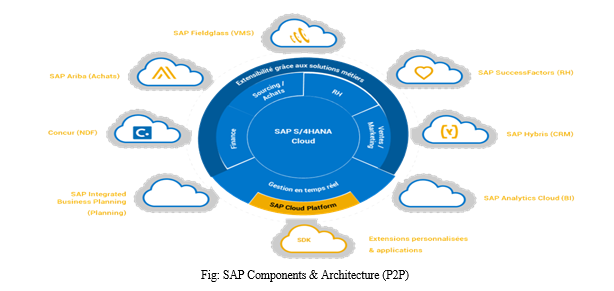
V. IMPLEMENTATION WITH SAP P2P CYCLE OF FIORI-

A. Components Involved in P2P Cycle
The Procure-to-Pay (P2P) cycle in SAP refers to the entire process a company undergoes to acquire goods or services from a vendor, culminating in the payment for those goods or services. Here are the key components involved in a typical SAP P2P cycle:
- Identification of Requirement: This initial step involves recognizing the need for a good or service within the organization. A department or employee initiates a Purchase Requisition (PR) outlining the specific details of the required item.
- Approval Workflow: The Purchase Requisition then goes through an approval process, ensuring adherence to budget constraints and proper authorization. Depending on the organization's structure, this may involve multiple levels of approval.
- Supplier Selection: Once the requisition is approved, the procurement team identifies potential vendors based on factors like price, quality, and past performance. This may involve requesting quotations or proposals from various suppliers.
- Purchase Order Creation: After selecting a vendor, a Purchase Order (PO) is created in SAP. The PO is a binding document that outlines the specific items being ordered, quantities, prices, delivery dates, and payment terms.
- Goods Receipt: Upon receiving the ordered goods from the vendor, a Goods Receipt (GR) is created in SAP. The GR documents the quantity and condition of the received items, along with any discrepancies from the original PO.
- Invoice Matching: The vendor then submits an invoice for the delivered goods or services. A three-way match is performed in SAP, comparing the PO, GR, and invoice to ensure they all align in terms of pricing, quantity, and description. Any discrepancies are flagged for resolution before proceeding with payment.
VI. PROCESS AND MODEL TO EXPLAIN THE FLOW:
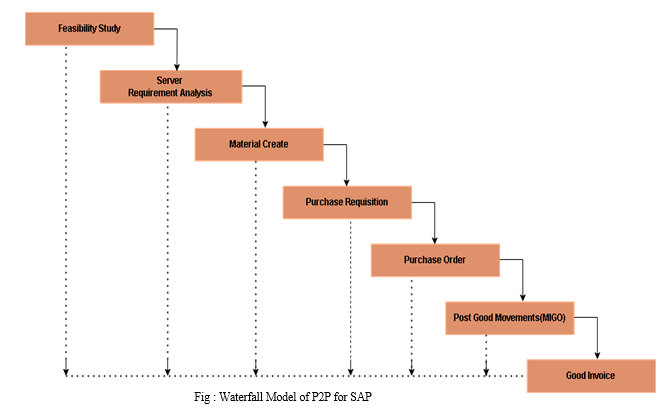
The P2P (Procure-to-Pay) cycle in SAP is the process of procuring goods and services from a supplier. The P2P cycle typically includes the following steps:
- Creating a purchase requisition
- Obtaining a quotation from a supplier
- Creating a purchase order
- Goods receipt
- Invoice receipt
- Payment
The waterfall model can be used to manage the P2P cycle in SAP. However, it is important to note that the waterfall model is not very flexible. If the requirements for the P2P cycle change, it can be difficult to make changes to the project plan.
VII. IMPLEMENTATION WITH FIORI
Fiori streamlines the Procure-to-Pay (P2P) process within SAP ERP by providing intuitive applications for key stages. Requesters can initiate purchase requisitions directly through Fiori, specifying item details and approvals. The system validates the request and triggers workflows for authorization. Upon approval, Fiori facilitates further P2P steps (potentially including purchase order creation, goods receipt confirmation, and invoice processing) through dedicated applications. This integration simplifies communication and data flow between users and the SAP ERP system, enhancing efficiency and transparency throughout the P2P cycle.

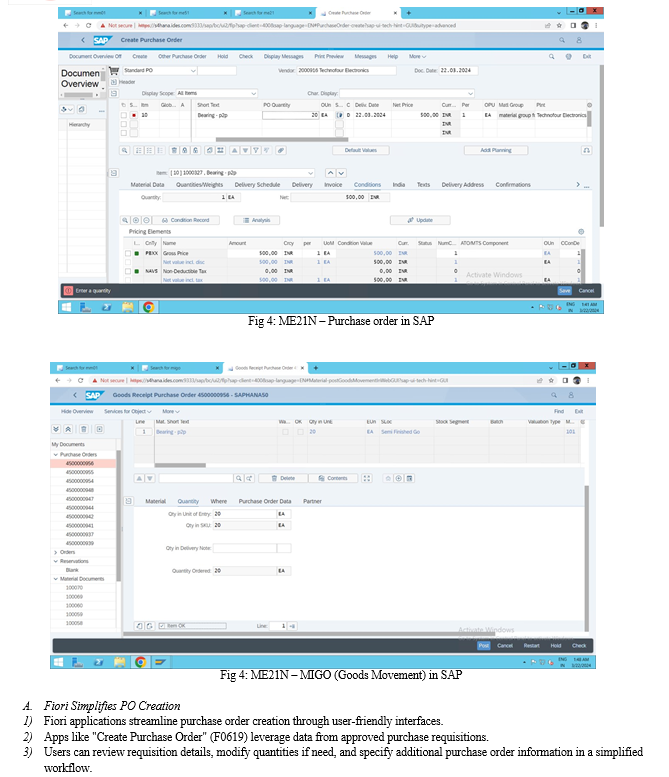
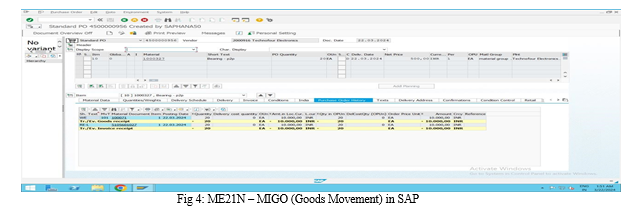
A. Fiori Streamlines Invoice Processing
- Fiori offers a modern app called "Create Supplier Invoice - Advanced" (F0640) to simplify invoice verification.
- This app leverages data from purchase orders and receiving documents, reducing manual entry for users.
- The interface provides a clear overview of invoice details and allows for efficient verification and posting.
B. Benefits of Fiori for Invoice Processing
- Reduced Errors: Pre-populated data minimizes the risk of errors during invoice entry.
- Increased Efficiency: The streamlined workflow expedites invoice processing.
- Improved Transparency: Users have a clear view of invoice details and associated documents.
- Enhanced User Experience: Fiori's user-friendly interface simplifies invoice verification compared to MIRO.
C. Integration of AI with ERP
Integrating Artificial Intelligence (AI) with Enterprise Resource Planning (ERP) systems holds significant potential to enhance various aspects of business operations, decision-making, and efficiency. Here's how AI can be integrated with ERP systems:
D. Data Analysis and Insights
- AI algorithms can analyze large volumes of data stored in ERP systems to identify patterns, trends, and correlations that humans may overlook.
- Machine learning models can predict future outcomes based on historical data, helping businesses make informed decisions.
- Natural Language Processing (NLP) techniques can extract insights from unstructured data sources such as emails, customer reviews, and social media, enriching the data available to ERP systems.
E. Process Automation
- AI-powered automation can streamline repetitive tasks within ERP workflows, such as data entry, invoice processing, and inventory management.
- Robotic Process Automation (RPA) bots can interact with ERP systems to perform routine tasks more efficiently and with fewer errors.
- AI algorithms can optimize resource allocation and scheduling in production planning and supply chain management modules of ERP systems.
F. Personalized User Experience
- AI can personalize the user experience within ERP systems based on individual user preferences, roles, and historical interactions.
- Recommender systems powered by AI can suggest relevant actions, reports, or modules to users based on their past activities and behavior.
G. Predictive Maintenance
- AI algorithms can analyze equipment sensor data stored in ERP systems to predict maintenance needs and prevent equipment failures before they occur.
- Predictive maintenance capabilities integrated with ERP systems can reduce downtime, minimize maintenance costs, and optimize asset utilization.
H. Customer Insights and Engagement
- AI can analyze customer data stored in ERP systems to identify buying patterns, preferences, and sentiment.
- AI-powered chatbots integrated with ERP systems can provide real-time customer support, process orders, and handle inquiries more efficiently.
I. Fraud Detection and Risk Management
- AI algorithms can analyze transactional data within ERP systems to detect anomalies and potential instances of fraud or non-compliance.
- AI-powered risk management modules can assess and mitigate risks across various business processes, such as financial transactions, procurement, and compliance.
J. Continuous Improvement
- AI-powered analytics integrated with ERP systems can provide insights into process inefficiencies and areas for improvement.
- AI-driven recommendations can help organizations optimize business processes, resource allocation, and decision-making over time.
The marriage of SAP Fiori and AI is rapidly reshaping business workflows. Imagine a world where Fiori applications not only display data, but actively assist you. AI is taking Fiori beyond simple automation. We're seeing a shift towards AI-powered "co-piloting," where the system intelligently suggests actions, predicts outcomes, and personalizes the user experience. For example, a Fiori app processing a purchase order might use AI to recommend the best supplier based on real-time market fluctuations and past performance, all while automatically filling in forms with relevant data. This not only saves time but empowers users to make data-driven decisions with greater confidence.
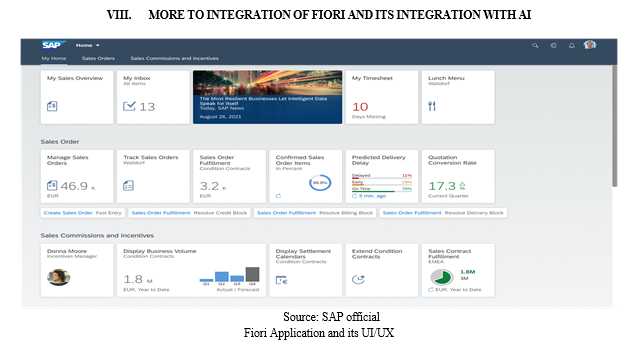
A. Conversational AI
- Beyond Chatbots: Move over, basic chatbots! Imagine Fiori applications seamlessly integrated with voice assistants like Alexa or Google Assistant, allowing hands-free interaction and natural language processing for complex tasks.
- Personalized Interactions: AI-powered conversational interfaces can adapt their responses and recommendations based on individual user preferences and past interactions, creating a truly personalized experience.
B. Hyper-automation
- Intelligent Process Automation (IPA): Taking automation beyond basic tasks, IPA integrates AI-powered decision-making into workflows, dynamically adjusting processes based on real-time data and insights.
- Self-healing Applications: Imagine Fiori applications automatically identifying and resolving issues before they impact users, ensuring seamless operation and minimal downtime.
C. Explainable AI (XAI)
- Building Trust: As AI becomes more complex, XAI techniques shed light on how AI models arrive at their decisions, fostering user trust and understanding.
- Counterfactual Explanations: Imagine Fiori applications explaining "what-if" scenarios, allowing users to explore the impact of different choices before making decisions.
D. Edge AI
- Decentralized Intelligence: Processing data closer to its source, at the edge of the network, enables Fiori applications to react faster and more efficiently, especially for time-sensitive tasks.
- Offline Capabilities: Imagine Fiori applications functioning even without internet connectivity, thanks to AI models trained to operate on local data and devices.
E. Generative AI
- Content Creation: Imagine AI-powered tools within Fiori applications automatically generating reports, summaries, or even personalized marketing materials based on user input and data.
- Interactive Simulations: AI can create realistic simulations of business scenarios within Fiori, allowing users to test different strategies and make informed decisions in a safe, virtual environment.
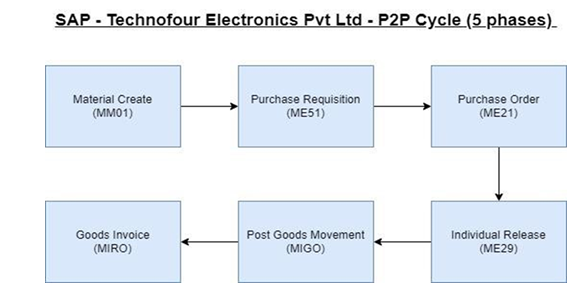
This is enhanced P2P cycle to existing ECC P2P cycle with elimination of individual release (ME51N).
- User Interface: ECC utilizes a menu-driven interface that can be complex and require extensive training to navigate. Fiori offers a role-based, user-friendly interface with intuitive tiles that provide quick access to relevant tasks.
- Automation: ECC relies heavily on manual data entry and processes. Fiori integrates AI and automation capabilities. This can involve pre-filling forms, suggesting actions, and streamlining approvals.
- Data Visibility: Information retrieval in ECC can be cumbersome. Fiori presents data more visually with dashboards and reports, allowing for better analysis and decision-making.
- Mobile Accessibility: ECC primarily functions on desktops. Fiori offers mobile-friendly apps, enabling users to access and manage the P2P process on the go.
These are just a glimpse into the exciting future of Fiori and AI integration. As technology continues to evolve, we can expect even more innovative and transformative applications that redefine how businesses operate and interact with data. And our aim is to continuously develop the new ways of integrating this application with AI as it will make business intelligence with rules of ERP more efficient and ease us in daily practices with SAP.
IX. FUTURE SCOPE
A. Biometric Authentication and Personalization
- Fiori as a Biometric Hub: Imagine Fiori applications seamlessly integrating with biometric sensors like facial recognition or voice recognition, enabling secure and personalized logins, context-aware interactions, and even adaptive interfaces that adjust to a user's emotional state.
- Neuro-Linguistic Programming (NLP) for Deeper Understanding: AI-powered NLP capabilities within Fiori could analyze user interactions, including natural language queries and voice commands, capturing not just the words but also the underlying intent and emotions, leading to more nuanced and personalized responses.
- Decision Support: AI can act as a co-pilot in Fiori, guiding users through complex tasks and surfacing the most relevant information for informed decision-making.
B. AI-powered Gamification and Engagement
- Gamified Learning and Training: Fiori applications could leverage AI-powered gamification techniques to create personalized learning experiences, incorporating points, badges, and leaderboards to motivate users, improve knowledge retention, and foster a culture of continuous learning.
- Interactive Simulations and Decision-Making Training: Imagine Fiori integrating with immersive simulations powered by AI, allowing users to practice real-world scenarios, test different approaches, and learn from their virtual experiences in a safe and engaging environment.
C. AI-driven Collaboration and Teamwork
- Intelligent Project Management: AI could analyze project data, predict potential bottlenecks, and suggest corrective actions within Fiori, optimizing resource allocation and ensuring project success.
- Adaptive Collaboration Tools: Imagine Fiori applications utilizing AI to recommend relevant team members for specific tasks, facilitate communication through sentiment analysis and conflict resolution techniques, and even predict team dynamics, fostering a more collaborative and productive work environment.
D. Ethical Considerations and Human-AI Partnerships
- Fiori as an Ethical AI Framework: Imagine Fiori acting as a central platform for ensuring ethical AI practices, incorporating explainable AI models, bias detection algorithms, and human oversight mechanisms, building trust and transparency in AI-driven decisions.
- Empowering Humans with AI Insights: Rather than replacing human jobs, Fiori and AI could work in tandem, amplifying human capabilities by providing real-time data, actionable insights, and cognitive support, enabling humans to focus on higher-level tasks and strategic decision-making.
E. Integration with the Metaverse and Beyond
- Immersive Fiori Experiences: Imagine Fiori applications seamlessly integrating with the Metaverse, allowing users to interact with data and applications in a 3D, virtual environment, facilitating collaboration, data visualization, and decision-making in a truly immersive way.
- AI-powered Predictive Maintenance in the Physical World: Imagine AI analyzing sensor data from physical assets in real-time within Fiori, predicting potential failures, and even triggering automated maintenance actions remotely, ensuring seamless operation and reducing downtime.
These are just a few of the unforeseen frontiers that Fiori and AI integration might explore. As technology continues to evolve at an exponential pace, the possibilities are endless. The key lies in harnessing the power of AI responsibly, ethically, and creatively, using Fiori as a platform to bridge the gap between data and decision-making, empowering users, and propelling organizations towards a brighter, more intelligent future.
Conclusion
The integration of Fiori and AI marks a seismic shift in how businesses interact with data and applications. It is not merely an evolution, but a revolution, transforming Fiori from a user interface into a cognitive co-pilot. This dynamic duo transcends basic automation, offering intelligent assistance, personalized insights, and predictive capabilities that empower users, optimize workflows, and unlock unparalleled business agility. As we venture further into the future, the possibilities become even more captivating. From biometrics and gamification to the Metaverse and beyond, the integration\'s potential seems limitless. However, the key lies not just in technological advancement, but in responsible and ethical implementation. By fostering a human-centric approach, where AI augments human capabilities while adhering to ethical principles, Fiori and AI can pave the way for a future where intelligent technology serves as a powerful tool for progress, shaping a world where data-driven insights fuel informed decisions and empower businesses to thrive. An optimized Procure-to-Pay (P2P) cycle is the backbone of efficient and cost-effective procurement within an organization. By integrating SAP Fiori and AI, businesses can unlock a new level of automation, intelligence, and user experience. Fiori streamlines the workflow with intuitive interfaces and mobile accessibility, while AI takes the P2P cycle beyond simple automation. Imagine a system that guides users with intelligent suggestions, predicts outcomes, and personalizes the experience for each employee. This empowers data-driven decision making, reduces errors, and ultimately saves valuable time and resources. The marriage of Fiori and AI signifies a paradigm shift in P2P management, paving the way for a future of intelligent and user-centric procurement processes. A. Future Implications Briefly touch upon the potential future advancements of Fiori and AI in the P2P space. This could involve: Advanced supplier risk management: AI can analyze vast amounts of supplier data to identify potential risks and ensure business continuity. 1) Self-learning Automation: AI-powered systems can continuously learn and improve, further automating tasks and optimizing the P2P process over time. 2) Blockchain Integration: Fiori and AI could be integrated with blockchain technology to create a more secure, transparent, and efficient P2P ecosystem. 3) Business Benefits: Reiterate the key benefits that businesses can expect from optimizing their P2P cycle with Fiori and AI. Emphasize not just cost savings and efficiency gains, but also: 4) Improved supplier Relationships: Streamlined communication and faster payments can foster stronger partnerships. 5) Enhanced Compliance: Automated processes and real-time data visibility can ensure adherence to regulations. 6) Strategic Decision-making: Data-driven insights can inform procurement strategies and optimize inventory management. By incorporating these additional points, you can create a more comprehensive and forward-looking conclusion that highlights the significant potential of SAP Fiori and AI in transforming the P2P landscape
References
[1] “SAP SE or an SAP affiliate company”. All rights reserved. ? PUBLIC (2021) [2] Al-Ghatrifi, I. N. “Cloud computing: A key enabler for higher education in Sultanate of Oma”. Presented at the 2015 International Conference on Computer, Communications, and Control Technology (I4CT), Kuching, 2015 [3] Leavitt, N. “Is Cloud computing really ready for prime time”. Growth, 27(5), 15–20 , 2009. [4] Linthicum, D. S. “Cloud computing and SOA convergence in your enterprise: a step-by step guide”. Upper Saddle River, NJ: Addison-Wesley, 2010. [5] SAP. “Kadir Has University: How Do You Provide Your Students and Faculty with a User Experience” That’s as Dynamic as They Are? Retrieved January 23, 2018 . [6] Zhang, Q., Cheng, L., & Boutaba, R. “Cloud computing: state-of-the-art and research challenges”. Journal of Internet Services and Applications, 1(1), 7–18, 2010. [7] Moyinuddeen Shaik, Guiding Your Journey to SAP S/4 HANA: Effective Migration Strategies, American Journal of Computer Architecture, Vol. 10 No. 2, 2023, pp. 37-41. [8] https://assets.dm.ux.sap.com/webinars/sap-user-groupsk4u/pdfs/201007_s4_op_licensing.pdf. [9] https://blog.asug.com/hubfs/2019%20AC%20Slide%20Decks%20Wednesday/ASUG82650%2020SAP%20S4HANA%20Licensing%20On%20Premise.pdf. [10] Moyinuddeen Shaik, Navigating the Evolution: Unveiling the Transformative Power of SaaS-Driven Business Models International Research Journal of Modernization in Engineering Technology and Science 05, no. 12 (2023).
Copyright
Copyright © 2024 Shreyas Sirse, Sushank Khanzode, Atharva Bhide, Prof. Vanita Gadekar. This is an open access article distributed under the Creative Commons Attribution License, which permits unrestricted use, distribution, and reproduction in any medium, provided the original work is properly cited.

Download Paper
Paper Id : IJRASET62796
Publish Date : 2024-05-27
ISSN : 2321-9653
Publisher Name : IJRASET
DOI Link : Click Here
 Submit Paper Online
Submit Paper Online

